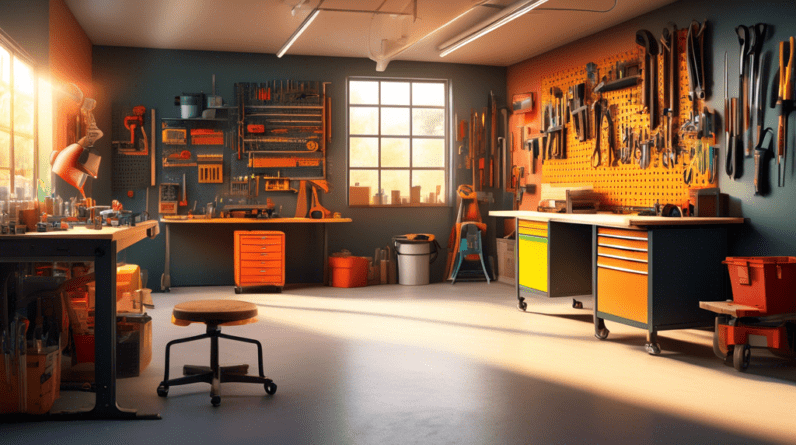
Introduction
Imagine this: you step into your garage, but instead of being greeted by clutter and cobwebs, you’re met with a clean, organized, and inspiring workspace. This isn’t a dream; it’s the reality of a well-planned garage transformation. Creating a productive workspace in your garage offers a sanctuary for your projects, hobbies, or even your primary work-from-home setup. This comprehensive guide will take you through the best practices to transform your garage into a highly functional and motivating workspace.
Assessing Your Needs and Goals
1. Define Your Purpose:
Before you start hauling boxes or picking out paint colors, take time to define the primary purpose of your garage workspace. Will it be a dedicated workshop for woodworking, a mechanic’s haven, a creative studio, a home office, or a multi-purpose area? Clearly identifying your goals will dictate the layout, storage solutions, and overall design.
2. Inventory and Declutter:
Now’s the time to face the music (or the mess). Empty out your garage entirely and take inventory of everything you have. Be ruthless in your decluttering process. Donate, sell, or discard anything that’s broken, unused, or no longer serves a purpose. This process, while potentially daunting, is essential for reclaiming your space.
3. Measure Your Space:
With a clean slate, accurately measure your garage’s dimensions, including ceiling height, door openings, and any existing fixtures. Note the location of electrical outlets, windows, and any structural elements that might influence your layout. Having these measurements readily available will be invaluable when planning your workspace and selecting furniture.
Planning and Design
1. Creating a Functional Layout:
The layout is crucial for workflow and efficiency. Consider these factors:
- Work Zones: Divide your space into distinct zones for specific tasks. For example, you might have a workbench area, a storage zone, and a separate space for hobbies like painting or music.
- Traffic Flow: Ensure there’s ample space to move freely between work zones and access tools or equipment without obstruction. A U-shaped or L-shaped layout often maximizes space and flow.
- Future Flexibility: Think about how your needs might evolve. Design with flexibility in mind, using modular furniture or mobile workbenches that can adapt to future projects or changes in your workspace requirements.
2. Lighting Matters:
Good lighting is essential for a productive and enjoyable workspace. Maximize natural light by cleaning windows and consider installing a skylight if possible. Supplement with ample artificial lighting:
- Overhead Lighting: Install bright, energy-efficient LED shop lights for general illumination.
- Task Lighting: Incorporate adjustable task lighting over workbenches, under cabinets, or in areas requiring focused illumination.
3. Power Up:
Evaluate your electrical needs early on. You’ll likely need additional outlets, especially if you’re using power tools or equipment:
- Dedicated Circuits: Consult an electrician to install dedicated circuits for high-powered equipment to prevent overloads.
- Strategic Placement: Strategically position outlets for easy access and to minimize the use of extension cords, which can be tripping hazards.
4. Climate Control:
Garages are notorious for temperature fluctuations. Consider these factors for a comfortable workspace year-round:
- Insulation: Proper insulation in the walls, ceiling, and garage door will help regulate temperature and reduce noise.
- Heating and Cooling: Depending on your climate, explore options for heating and cooling. Space heaters, portable air conditioners, or extending your home’s HVAC system are possibilities.
- Ventilation: Ensure adequate ventilation to exhaust fumes from paints, solvents, or machinery. Install exhaust fans or consider a fresh air intake system.
Flooring, Walls, and Storage
1. Durable Flooring:
Your garage floor should withstand heavy traffic, spills, and the occasional dropped tool. Popular choices include:
- Epoxy Coating: Durable, easy to clean, and resistant to chemicals.
- Interlocking Floor Tiles: Provide cushioning, insulation, and easy installation.
- Sealed Concrete: A cost-effective option that can be stained or painted.
2. Functional Walls:
Maximize vertical space with wall-mounted storage solutions to keep your workspace clutter-free:
- Pegboards: Versatile and perfect for organizing hand tools, small parts, and frequently used items.
- Slatwall Systems: Offer adjustable shelving, hooks, and accessories for customizable storage.
- Open Shelving: Easy access to frequently used items, but ensure it’s kept tidy.
- Cabinets: Ideal for storing larger tools, equipment, or materials while providing a cleaner look.
3. Smart Storage Solutions:
Efficient storage is key to a productive workspace:
- Mobile Workbenches: Provide additional work surface and storage while offering flexibility.
- Clear Storage Bins: Allow you to see the contents easily, making it easier to find what you need.
- Vertical Storage: Utilize ceiling space with overhead racks or shelves for storing seasonal items or less frequently used equipment.
Ergonomics and Safety
1. Ergonomic Considerations:
A comfortable workspace is a productive one. Prioritize ergonomics:
- Adjustable Workbench: Choose a workbench at a comfortable height to prevent back strain.
- Ergonomic Chair: Invest in a supportive chair that promotes good posture, especially if you spend long hours at your workspace.
- Anti-Fatigue Mats: Provide cushioning and support for your feet if you’re standing for extended periods.
2. Safety First:
Safety should be paramount in any workspace, especially when working with tools or machinery:
- Fire Safety: Install smoke detectors and a fire extinguisher, and ensure you have a clear evacuation plan.
- First Aid Kit: Keep a well-stocked first aid kit readily accessible.
- Personal Protective Equipment (PPE): Always wear appropriate PPE, such as safety glasses, ear protection, gloves, and respirators, when necessary.
- Tool Storage: Store tools safely to prevent accidents. Use tool chests, wall mounts, or pegboards to keep them organized and out of reach of children.
Personalizing Your Workspace
1. Inject Your Style:
This is your space to enjoy, so inject your personality and style. Choose colors, décor, and accessories that inspire you and create a motivating atmosphere.
2. Add Some Life:
Plants can brighten up your workspace and improve air quality. Choose low-maintenance varieties that can tolerate the garage’s conditions.
3. Sound System:
Music or podcasts can make working in the garage more enjoyable. Set up a sound system that suits your preferences.
4. Create a Vision Board:
Hang a vision board or inspirational quotes to keep you motivated and focused on your goals.
Conclusion
Transforming your garage into a productive workspace is an investment in your hobbies, passions, or professional endeavors. By following these best practices, you can create a functional, organized, and inspiring space that enhances your productivity and brings your projects to life.






